Human Orbital Spaceflights
![]()
International Flight No. 211STS-103Discovery (27)96th Space Shuttle missionUSA |
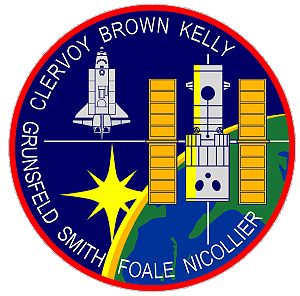 |
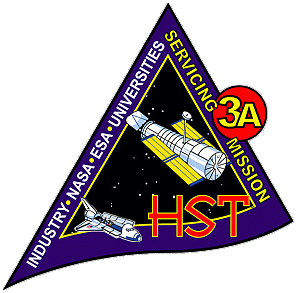 |
![]()
Launch, orbit and landing data
walkout photo |
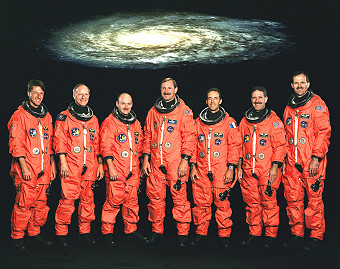 |
||||||||||||||||||||||||||||
alternative crew photo |
|||||||||||||||||||||||||||||
alternative crew photo |
|||||||||||||||||||||||||||||
alternative crew photo |
Crew
| No. | Surname | Given names | Position | Flight No. | Duration | Orbits | |
| 1 | Brown | Curtis Lee, Jr. "Curt" | CDR | 6 | 7d 23h 10m 47s | 119 | |
| 2 | Kelly | Scott Joseph | PLT | 1 | 7d 23h 10m 47s | 119 | |
| 3 | Smith | Steven Lee | MS-1, PLC, EV-1 | 3 | 7d 23h 10m 47s | 119 | |
| 4 | Clervoy | Jean-François André | MS-2, RMS, FE | 3 | 7d 23h 10m 47s | 119 | |
| 5 | Grunsfeld | John Mace | MS-3, EV-2 | 3 | 7d 23h 10m 47s | 119 | |
| 6 | Foale | Colin Michael | MS-4, EV-3 | 5 | 7d 23h 10m 47s | 119 | |
| 7 | Nicollier | Claude | MS-5, EV-4 | 4 | 7d 23h 10m 47s | 119 |
Crew seating arrangement
|
 |
|
||||||||||||||||||||||||||||||||
Hardware
| Orbiter : | OV-103 (27.) |
| SSME (1 / 2 / 3): | 2053-2A (1.) / 2043-2A (3.) / 2049-2A (2.) |
| SRB: | BI-099 / RSRM 73 |
| ET: | ET-101 (SLWT-6) |
| OMS Pod: | Left Pod 01 (30.) / Right Pod 03 (28.) |
| FWD RCS Pod: | FRC 3 (27.) |
| RMS: | 301 (18.) |
| EMU: | EMU No. 3015 (PLSS No. 1015) / EMU No. 3017 (PLSS No. 1017) / EMU No. 3003 (PLSS No. 1003) / EMU No. 3008 (PLSS No. 1008) |
Flight
|
Launch from Cape Canaveral (KSC) and
landing on Cape Canaveral (KSC), Runway 33. Hubble Space Telescope (HST) servicing mission SM-3A, was delayed repeatedly by technical problems with the shuttle fleet after the near-disastrous previous launch of STS-93. The launch was scrubbed three times: On December 06, 1999 (technical problems), on December 16, 1999 (again technical problems) and on December 18, 1999 (weather). NASA officials decided to move up part of the servicing mission that had been scheduled for June 2000 after three of the telescope's six gyroscopes failed. Three gyroscopes must be working to meet the telescope's very precise pointing requirements, and the telescope's flight rules dictated that NASA consider a "call-up" mission before a fourth gyroscope failed. Four new gyros were installed during the first servicing mission (STS-61) in December 1993 and all six gyros were working during the second servicing mission (STS-82) in February 1997. Since then, a gyro failed in 1997, another in 1998 and a third in 1999. The Hubble team believed they understood the cause of the failures, although they could not be certain until the gyros were returned from space. Having fewer than three working gyroscopes would have precluded science observations, although the telescope would have remained safely in orbit until a servicing crew arrived. Hubble's gyros spin at a constant rate of 19,200 rpm on gas bearings. This wheel is mounted in a sealed cylinder, which floats in a thick fluid. Electricity is carried to the motor by thin wires (approximately the size of a human hair). It is believed that oxygen in the pressurized air used during the assembly process caused the wires to corrode and break. The new gyros were assembled using nitrogen instead of oxygen. Each gyroscope is packaged in a Rate Sensor assembly. The Rate Sensors are packaged in pairs into an assembly called a Rate Sensor Unit (RSU). It is the RSUs that the STS-103's astronauts changed. The RSUs each weigh 11.0 kilograms (24 lb) and are 12.8 by 10.5 by 8.9 inches (325 by 267 by 226 mm) in size. The primary objective of the Hubble-Servicing-Mission 3A was to replace all six gyroscopes that make up the three Rate Sensor Units. In addition, astronauts installed a new computer that dramatically increased the computing power, speed, and storage capability of HST. They change out one of the Fine Guidance Sensors and replaced a tape recorder with a new Solid State Recorder. The EVA crew also installed a new S-band single access transmitter and voltage/temperature improvement kit for the telescope's nickel-hydrogen batteries. Finally, the crew began repair of the insulation on the telescope's outer surface that had deteriorated in the years since it was launched. Discovery's initial rendezvous burn was the launch of the shuttle from the Kennedy Space Center, FL. The launch was precisely timed to occur during about a 42-minute launch window as the telescope passed within a prescribed distance of the launch site. After launch, mission control and the crew will oversee a number of orbits adjust and course correction burns to catch up with and retrieve the telescope on flight day three of the mission. Once Discovery was safely in orbit and the payload bay doors were opened, the Ku-band antenna was activated and used to provide radar data to the crew and ground during the rendezvous process. The day after launch, the crew had checkout the shuttle's robot arm (Remote Manipulator System) to be used throughout the mission. Also, activation of the space support equipment was performed. This included activating the flight support system and heaters on the orbital replacement unit carrier housing the scientific instruments and hardware that will be installed on the telescope. The terminal initiation burn occurred about two hours prior to capture as the shuttle reached a distance of about eight miles behind Hubble. Several small correction burns followed before Commander Curtis Brown took over manual control of Discovery at a distance of about 2,500 feet (762 meters) below. The approach from underneath minimized any potential contamination to the telescope from the shuttle's thruster firings. Because Hubble was placed in a configuration to keep it pointed to the Sun due to its latest gyroscope failure, Curtis Brown had to conduct a partial flyaround of the telescope to align the Shuttle's robot arm with Hubble's grapple fixture. When Discovery reached a point about 35 feet (10.7 meters) from Hubble, astronaut Jean-François Clervoy used the robot arm to capture the telescope's grapple fixture located midway up the HST structure. Following capture, Hubble was lowered onto the flight support system, a turntable likened to a 'Lazy Susan' for its ability to rotate and tilt to assist in the servicing tasks. An electrical cable was remotely attached to provide orbiter power to the telescope throughout the servicing portion of the mission. The third servicing mission to the Hubble Space Telescope includes four planned spacewalks by four astronauts completely cross-trained to perform any of the scheduled tasks on any day. One EVA later was cancelled. Hubble was designed to be serviced while on orbit through Extravehicular Activity (EVA). The telescope has two grapple fixtures for the shuttle's robot arm, handholds and handrails for use by the astronauts, and electrical connections and bolts designed for easier manipulation by the crew while wearing pressurized space suits. The first EVA by Steven Smith and John Grunsfeld was performed on December 22, 1999 (8h 15m) in which three Rate Sensor Units with each two gyroscopes were replaced, because four gyroscopes had failed. They also opened valves on the NICMOS to purge nitrogen coolant from that instrument and installed Voltage/Temperature Improvement Kits. The first spacewalk featured the replacement of all three Rate Sensor Units (RSU's) (two were replaced on the first servicing mission - STS-61). Each RSU houses two gyroscopes used to point the telescope for observations. In addition, Steven Smith and John Grunsfeld then installed voltage/temperature improvement kits (VIK) to protect Hubble's batteries from overheating as they get older. The VIK lowers each battery's charge termination voltage. They also opened coolant valves and removed caps on the Near Infrared Camera and Multi-Object Spectrometer, which was installed on the second visit to Hubble in 1997. NICMOS was found to be leaking its super-cold coolant shortly after activation. Opening the valves allowed any residual coolant frozen in the line to dissipate in the vacuum of space in preparation for work scheduled on the next visit in 2001. The Rate Sensor Units allow the Telescope to point at stars, planets and other celestial targets. Three are aboard Hubble, and each unit contains two gyroscopes. Hubble needs three of these six gyroscopes to meet its very precise pointing requirements, and the other three are spares. (Gyroscopes have limited lifetimes, and currently only two are working properly.) As a result, all science operations have been temporarily suspended. Astronauts will replace all three units, leaving Hubble with six fresh gyroscopes. Astronauts installed a battery Voltage/Temperature Improvement Kit (VIK) on each of the Hubble's six batteries. Hubble's batteries are fully charged each orbit by the Solar Arrays. Each battery is fully charged when its respective charge controller senses a specific charge cutoff voltage. The VIK modifies the charge cutoff voltage to a lower level to prevent battery overcharging and associated overheating. In the Telescope, the batteries are located in two compartments, called bays, three batteries to a bay. The VIK is a simple device, about the size of a cell phone, weighing about three pounds. An automobile has a voltage regulator to control the rate of charge into its car battery. Similarly, Hubble has charging regulators for its batteries. Hubble's regulators use battery voltage and battery temperature to control the rate of charge into the batteries. The batteries aboard Hubble are almost 10 years old. They still do the job well but, as they age, they become more sensitive to the way they are charged and become susceptible to overheating. The second EVA by Michael Foale and Claude Nicollier occurred on December 23, 1999 (8h 10m). They replaced the outmoded DF-224-Computer and installed a new and better computer (20 times faster) and replaced a 500-pound (227 kg) Fine Guidance Sensor (FGS). The old computer, called the DF-224, was designed in the late 1970's and its capabilities are less advanced than today's modern computers. Programming requires very specialized skills, unique to this computer, and maintaining the software is difficult and expensive. The DF-224 computer has degraded over the years and during the First Servicing Mission in 1993 it was augmented with an additional computer called a co-processor. The design of the co-processor was based on the Intel 80386 microchip. The new advanced computer was based on the Intel 80486 microchip. The new computer was 20 times faster, and had six times as much memory, as the old computer on Hubble. In a good example of NASA's goal of "faster, cheaper, better," commercially developed, commonly available equipment was used to build this new computer at a fraction of the price it would cost to build a specialized computer designed specifically for the spaceflight environment. NASA performed a number of mechanical, electrical, radiation and thermal tests to guarantee that the computer would survive the trip to orbit, withstand bombardment by cosmic and solar radiation and work flawlessly in the extreme temperatures of space for the rest of Hubble's life. During the Hubble Space Telescope Servicing Mission 3A, astronauts exchanged the Fine Guidance Sensor (FGS) with a refurbished unit that had an enhanced on-orbit alignment capability. The refurbished FGS on SM3A is the same unit that was returned from Servicing Mission 2. The FGS returned from SM3A will be refurbished and upgraded for re-use on Hubble's 4th Servicing Mission. An FGS, an optical sensor, consists of a large structure housing a collection of mirrors, lenses, servos, prisms, beam-splitters and photomultiplier tubes. The FGS is 5.5 x 4 x 2 feet (1.7 x 1.2 x 0.6 meters), weighs 478 pounds (217 kg) and has 19 watts of power. The fine guidance sensors are one of the sensors used by Hubble's pointing control system to point the Telescope at a target with an accuracy of 0.01 arcsec. An arcsec is the width of a paperclip wire viewed from the distance of two football fields. With this fine precision, the guidance sensors lock on to a star and then measure any apparent motion to an accuracy of 0.0028 arcsec. This gives Hubble the ability to remain pointed at that target with no more than 0.007 arc-sec of deviation over long periods of time. This level of stability and precision is comparable to being able to hold a laser beam focused on a dime that is 200 miles (322 km) away (the distance from Washington D.C. to New York City). The third and final EVA was conducted by Steven Smith and John Grunsfeld on December 24, 1999 (8h 08m) to replace a failed S-band transmitter and a Solid State Recorder. They also applied some new insulation on equipment bay doors to minimize degradation of the telescope's protective thermal coverings. The S-Band Single Access Transmitter (SSAT) sends the data from Hubble Space Telescope to the ground by radio. There are two identical S-Band Single Access Transmitters on-board Hubble. "S-Band" identifies the radio frequency and "Single Access" specifies a type of antenna on NASA's communications satellites. One of the two SSATs failed in 1998. The other SSAT has been able to shoulder the load and Hubble's observing program has not been affected. Hubble can operate with one transmitter by making additional commands to rotate the telescope. Optimally, the telescope operates with two SSATs. The SSAT is 14 x 8 x 2 3/4 inches (35 x 20 x 7 centimeters) and weighs 8.5 pounds (3.9 kg). Some of the cables and connectors are smaller versions of the ones on the back of television sets. Because the connectors are difficult to handle with bulky space suit gloves, special enhancements have been made to the new unit to aid the astronauts. In addition, a special connector tool helps to remove and install the connectors. The failed transmitter was returned to Earth and refurbished for a later flight. Prior to the Second Servicing Mission, Hubble used three 1970s-style, reel-to-reel tape recorders. In February 1997, astronauts replaced one of these mechanical recorders with a digital Solid State Recorder. During Servicing Mission 3A, astronauts removed a second mechanical tape recorder and install a second Solid State Recorder. Unlike the reel-to-reel recorder it replaces, the Solid State Recorder has no reels, no tape, and no moving parts to wear out and limit lifetime. Data is digitally stored in computer-like memory chips until Hubble's operators command its playback. Although the Solid State Recorder is about the same size and shape as the reel-to-reel recorder, it can hold approximately ten times as much data. It stores 12 gigabits of data, while the tape recorder it replaces can hold only 1.2 gigabits. This ten times greater storage has proven essential in allowing Hubble's new, high-tech scientific instruments to be fully productive. The Solid State Recorder is 12 x 9 x 7 inches (30 x 23 x 18 centimeters) and weighs 25 pounds (11.3 kg). During the 1999 servicing mission, astronauts covered Hubble Space Telescope with permanent sheets called the New Outer Blanket Layer, or NOBL. The crew also carried a special fabric, called the Shell/Shield Replacement Fabric, or SSRF. The NOBL covers and SSRF pieces are designed to protect Hubble's external blankets. They will prevent Hubble's insulation from further degradation and maintain normal operating temperatures. NASA tested the materials to ensure that they can withstand exposure to charged particles, X-rays, ultraviolet radiation, and thermal cycling for at least ten years. Astronauts installed seven NOBL covers on Hubble's electronics bay doors. The covers are specially coated stainless steel foil trimmed to fit each particular door. Each cover is supported by a steel picture-frame structure. Expanding plugs, like common kitchen bottle stoppers, fit into door vent holes to allow quick installation. On December 25, 1999, the day after the spacewalks were completed, the solar arrays on Hubble were pointed toward the sun to provide electrical power and to charge the observatory's batteries. The robot arm was used to grapple the telescope once again followed by transfer of power to Hubble's internal system from the orbiter power. The twin high-gain antennas were deployed and the telescope then were lifted off of the flight support system and released over the side of the orbiter in similar fashion to the deploy on both previous servicing missions. STS-103 also carried hundreds of thousands of student signatures as part of the Student Signatures in Space (S3) program. The unique project provided elementary schools (selected on a rotating basis) with special posters to be autographed by students, then scanned onto disks and carried aboard a NASA Space Shuttle mission. On STS-103, Discovery reached the highest orbit ever flown in the program's history, at the apogee of 610 kilometers (378 mi) above Earth. |
EVA data
| Name | Start | End | Duration | Mission | Airlock | Suit | |
| EVA | Smith, Steven | 22.12.1999, 18:54 UTC | 23.12.1999, 03:09 UTC | 8h 15m | STS-103 | Discovery | EMU No. 3015 |
| EVA | Grunsfeld, John | 22.12.1999, 18:54 UTC | 22.12.1999, 03:09 UTC | 8h 15m | STS-103 | Discovery | EMU No. 3017 |
| EVA | Nicollier, Claude | 23.12.1999, 19:06 UTC | 24.12.1999, 03:16 UTC | 8h 10m | STS-103 | Discovery | EMU No. 3008 |
| EVA | Foale, Michael | 23.12.1999, 19:06 UTC | 24.12.1999, 03:16 UTC | 8h 10m | STS-103 | Discovery | EMU No. 3003 |
| EVA | Smith, Steven | 24.12.1999, 19:17 UTC | 25.12.1999, 03:25 UTC | 8h 08m | STS-103 | Discovery | EMU No. 3015 |
| EVA | Grunsfeld, John | 24.12.1999, 19:17 UTC | 15.12.1998, 03:25 UTC | 8h 08m | STS-103 | Discovery | EMU No. 3003 |
Photos / Graphics
 |
 |
 |
 |
 |
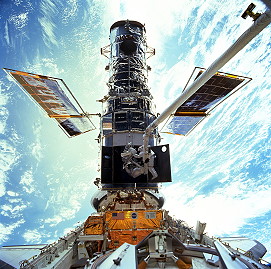 |
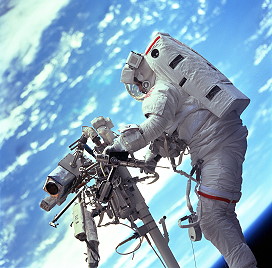 |
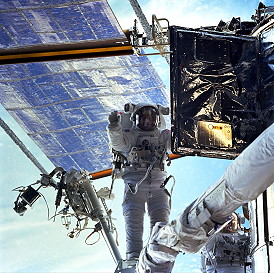 |
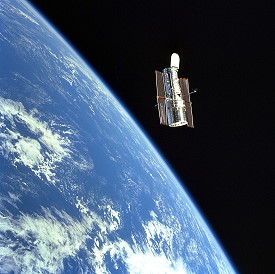 |
 |
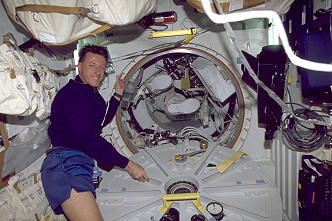 |
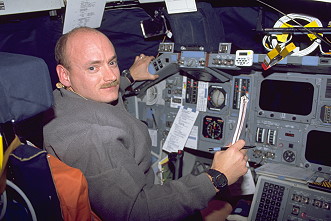 |
 |
 |
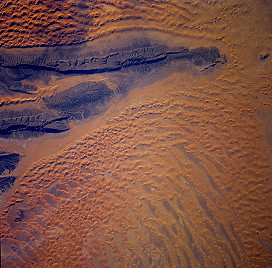 |
 |
more EVA photos |
|
| © |  |
Last update on March 27, 2020.  |
 |